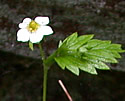Fragaria vesca (Woodland Strawberry)
| Also known as: | American Wood Strawberry |
|---|---|
| Genus: | Fragaria |
| Family: | Rosaceae (Rose) |
| Life cycle: | perennial |
| Origin: | native |
| Habitat: | part shade, shade; average to moist soil, woods, thickets |
| Bloom season: | April - June |
| Plant height: | 6 to 12 inches |
| Wetland Indicator Status: | GP: UPL MW: UPL NCNE: UPL |
| MN county distribution (click map to enlarge): |  |
| National distribution (click map to enlarge): |  |
Pick an image for a larger view. See the glossary for icon descriptions.
Detailed Information
Flower: 

![[photo of flower]](/udata/r9ndp23q/pd/fragaria-vesca-2-t.jpg) Clusters of 2 to 5 flowers, generally blooming 1 or a few at a time, on a slender stem that usually exceeds the height of surrounding leaves. Flowers are typically less than ½ inch wide with 5 round to oval white petals, about 20 yellow stamens surrounding a yellow center, and sharply pointed sepals as long as or longer than the petals. A small leaflet-like bract is usually present where flower stalks diverge at the top of the stem.
Clusters of 2 to 5 flowers, generally blooming 1 or a few at a time, on a slender stem that usually exceeds the height of surrounding leaves. Flowers are typically less than ½ inch wide with 5 round to oval white petals, about 20 yellow stamens surrounding a yellow center, and sharply pointed sepals as long as or longer than the petals. A small leaflet-like bract is usually present where flower stalks diverge at the top of the stem.
Leaves and stems: 


![[photo of leaves]](/udata/r9ndp23q/white/woodland-strawberry-100_4417-t.jpg) Leaves are evergreen, basal and palmately compound in groups of 3. Leaflets are 1 to 1½ inches long, ¾ to 1 inch wide, coarsely toothed, nearly hairless on upper surface, prominently veined, oval to egg-shaped, rounded towards the tip and tapered toward the base. Leaflets are stalkless, the compound leaf on a long sparsely hairy stem. The tooth at the very tip of a leaflet is mostly about equal in size and extending beyond the teeth on either side of it, though may be somewhat smaller on some leaflets. Stems are above ground runners (stolons) that root at tips from which a crown of leaves emerge.
Leaves are evergreen, basal and palmately compound in groups of 3. Leaflets are 1 to 1½ inches long, ¾ to 1 inch wide, coarsely toothed, nearly hairless on upper surface, prominently veined, oval to egg-shaped, rounded towards the tip and tapered toward the base. Leaflets are stalkless, the compound leaf on a long sparsely hairy stem. The tooth at the very tip of a leaflet is mostly about equal in size and extending beyond the teeth on either side of it, though may be somewhat smaller on some leaflets. Stems are above ground runners (stolons) that root at tips from which a crown of leaves emerge.
Fruit: 
![[photo of fruit]](/udata/r9ndp23q/white/woodland-strawberry-100_6318-t.jpg) Small red strawberries are egg shaped to conic, the tiny seeds (achenes) raised on the surface. These berries are really tasty!
Small red strawberries are egg shaped to conic, the tiny seeds (achenes) raised on the surface. These berries are really tasty!
Notes:
To say the least this small red strawberry can be easily confused with another small red strawberry, the closely related Fragaria virginiana, especially as both are widespread and common. The 2 can be distinguished by the following: terminal tooth being mostly equal in size to side teeth on F. vesca, consistently smaller on F. virginiana; F. vesca leaflets are sparsely hairy, more prominently veined with large teeth, F. virginiana is more softly veined and toothed, and hairier overall; F. vesca fruit has seeds raised on the surface, F. virginiana fruit is more globular with seeds in shallow pits; F. vesca flowers are fewer in number than F. virginiana and typically rise above the leaves, where F. virginiana flower stems are typically shorter than the leaf stems; F. vesca prefers moister, shadier habitat than F. virginiana. This species is native to both old and new worlds. There are 4 varieties, with var. americana native to Minnesota.
Both native strawberries are great alternatives to turfgrass lawns or as a green mulch in gardens. #altlawn
Native Plant Nurseries, Restoration and Landscaping Services ↓
More photos
 Woodland Strawberry plant
Woodland Strawberry plant Woodland Strawberry plant
Woodland Strawberry plant garden-grown Woodland Strawberry
garden-grown Woodland Strawberry flowering stem rises above the leaves
flowering stem rises above the leaves not enough for shortcake yet!
not enough for shortcake yet!
Photos by K. Chayka and Peter M. Dziuk taken in various locations around the state - it is pretty ubiquitous.
Comments
Have you seen this plant in Minnesota, or have any other comments about it?
on: 2011-07-15 13:33:42
Currently in fruit throughout the woods across the road from our home in South St Paul. One note on why this one is so easy to find in fruit, unlike its tasty sunny-meadow cousin that gets gobbled up by the critters as fast as it ripens - Fragaria vesca does NOT taste very good, has a kind of skunky undertone to it, so the birds and other critters aren't very interested in it. (Found that out the hard way when I was a little kid!)
on: 2016-06-21 23:30:35
Walking the Discovery Trail and saw a bunch today. Very pretty. Knew it wouldn't taste like a wild strawberry but was curious--just tasted like nothing--watery nothing.
on: 2018-12-16 20:54:13
I spotted a patch in a forest at Kilen Woods State Park.
on: 2019-07-03 13:37:49
Appeared to be cultivated deliberately. The berries did not taste like strawberries, but they had a pleasant enough flavor that I ate several dozen and liked them. More crunchy seeds than familiar wild strawberries.






